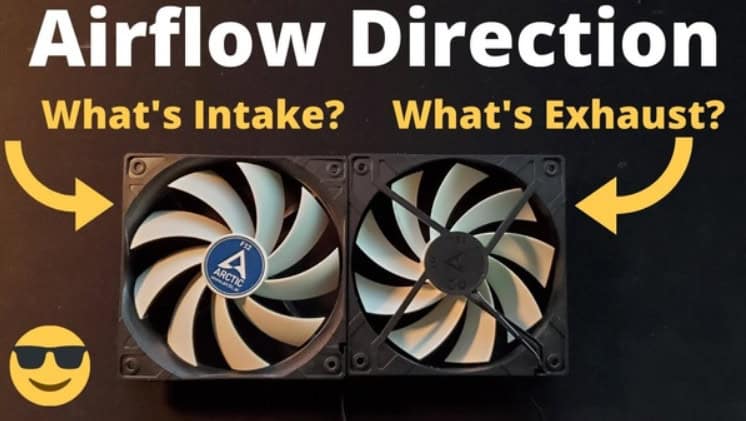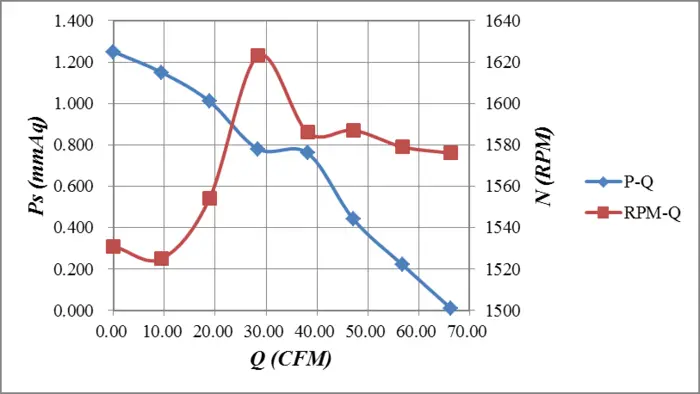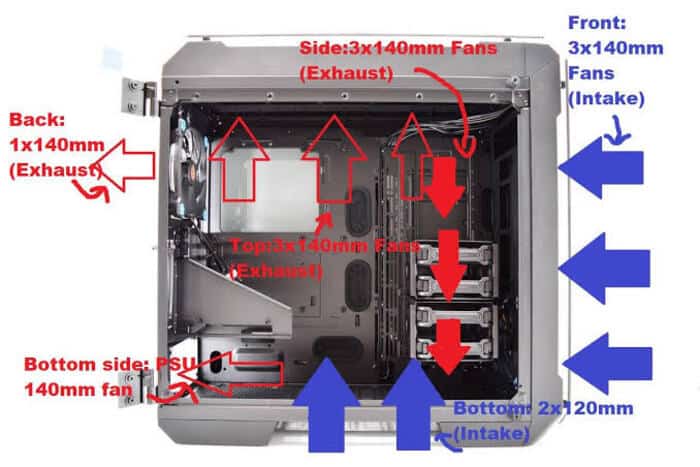You’ve made your decision! You have worked up the courage to construct a computer from the ground up, compiling a list of all the best options. Hold on a second; what about the fan on your computer? It’s a critical component that you need to pick up carefully. So, here’s a simple guide for those deciding between an ‘intake vs. exhaust fan’ for their computer.
We’ll consider all available criteria to assist you in deciding which fan to choose and offer you all other pertinent information! The primary difference between the intake and exhaust fan is that intake fans take in cool air, and the exhaust fan pushes the warm air out of your system to keep it cool and stabilize the PC’s performance.
After all, choosing the greatest fan for your computer is the best method to keep it cool! So, continue reading! You’ll also receive responses to all of your queries.
See also: 19 Best Fan Control Software for Your Windows PC
What Is The Difference Between Intake And Exhaust Fans?
The critical difference between an intake vs. exhaust fan is pretty straightforward, Intake fans draw fresh air into the computer, while exhaust fans actively expel stagnant air. Intake and exhaust fans are attached to your computer’s case rather than directly to the components. They can work together to regulate the temperature in your home at a comfortable level. There are Grills of four screw-size holes in each corner of your case. These are the locations where you can install intake and exhaust fans.
They get their power by plugging into three or four-pin sockets on the computer’s motherboard. If you want to buy fans for your PC, know where each socket is on your motherboard and how many you have.
What Are Intake And Exhaust Fans?
Whenever a heatsink removes heat from corresponding components, the heated air stays within your PC, warming it up. The fans are reusing the “old air” to cool the system, which isn’t ideal.
The trick is to install fans that either remove the heat from the room or bring in fresh, cooler air. Intake and exhaust fans play this duty and determine how pc fans blow.
Intake vs Exhaust Fans
We can do the following with just one intake and one exhaust fan:
- The intake fans allow fresh air to enter.
- Intake fans supply cool air, and the fresh air mixes with it. Heatsinks employ this cool air to extract heat from components, which results in hot air.
- Exhaust fans drive the warm air out of the computer.
We have an easy intake, then extract, and finally, an exhaust system, regularly supplying cool air to the computer. In contrast, heated air is evacuated out from the computer fan direction. It is known as “airflow” on a computer and is a beautiful technique to get the most out of your system’s fans.
The Choice
As you may have seen, many fans don’t specify whether they’re intake or exhaust fans. It could be because they can be both! Not only will the fan operate regardless of which side you mount toward the casing, but it should also indicate how it pushes air on the fan unit itself. It means you can have two fans for the price of one. Install one to pull in philosophy and the other to push it out.
So, the intake vs. exhaust fans debate comes down to airflow on your pc, and using a combination of both intake and exhaust fans can do the work.
See Also: 17 Best CPU Temperature Monitor Software to Try in 2023
Ways To Determine Intake vs Exhaust Fan In A Computer
So, you have successfully set up a PC fan, but now you are confused about which type of fan it is. Don’t you worry! Here are a few ways to determine.
1. Locate Directional Arrows
On the fan housing of most fans, there are two directional arrows. The horizontal arrow indicates the airflow direction, while the vertical arrow indicates the order in which the fan spins.
You should be able to find the two indicators on the outside rim of the fan.
2. Checking Propeller.
You can also examine the propeller’s design and its rotation direction. The intake side is the one with the visible edges. In the intake section, the blades revolve to the right concerning the CPU fan direction.
Other Factors
There are some other factors to consider
CFM
The rating of a fan’s CFM (Cubic Feet per Minute) indicates how much air it can move per minute.
The greater this number is, the more air your system’s fan will push in or out. The more, the merrier in this scenario!
RPM
The RPM (Revolutions Per Minute) measures how quickly a fan rotates. The fan will spin faster if this number is higher.
The fan will spin faster if this number is higher.
dBA
It refers to the decibel measurement. It denotes the maximum volume that the fan can produce.
If silent fans are essential to you, get one with a low dBA.
Case of Air Pressure
One of the most hotly argued topics in computer cooling is the best air pressure for a computer case. In simple words, a computer case can have one of the following features:
- Positive pressure– When the case fans push more air into the case than they pull out through the pc fan direction, the air pressure within the subject is higher.

- Neutral Pressure- Neutral pressure occurs air pressure inside the case equals air pressure outside the case, resulting in neutral pressure. Unless you leave the case open, it isn’t easy to achieve.

- Negative Pressure- Negative pressure occurs when more air is drawn out of the case than forced, resulting in a vacuum.

Aim for slightly positive pressure, with intake CFM slightly higher than exhaust CFM. Negative pressure implies air is sucked into your case through the tiny openings you can’t control and aren’t filtering, resulting in less efficient cooling over time. As a result, the air entering your case first passes through a filter. You’d have neutral pressure with an enclosed enclosure in a perfect world since no dust shall be sucked in.
These are all the points you should consider if you are stuck in the intake vs. exhaust fan debate.
FAQs
Can an exhaust fan be used for intake?
You can use an exhaust fan for intake as a fan will operate regardless of whichever side you mount towards the casing.
Is having all intake or all exhaust fans harmful for pc?
You can manage airflow to all elements that need cooling by employing a mix of intake and exhaust fans and their placement. It would be chaotic if all intake or exhaust fans were turned on, overheating some components.
Conclusion
Building a computer from the ground up might be complex, especially if you are not a geek! Choosing the right fan for your laptop is one method to ensure that it receives the cooling it needs. I hope you solved your intake vs. exhaust fan dilemma due to today’s article! And have now decided on which one to purchase.



